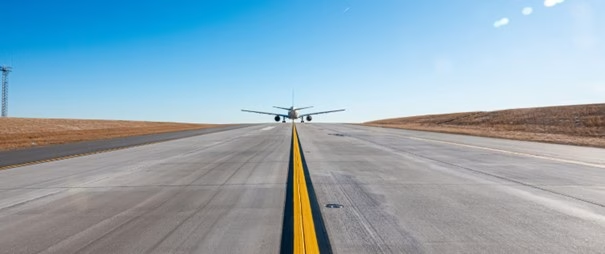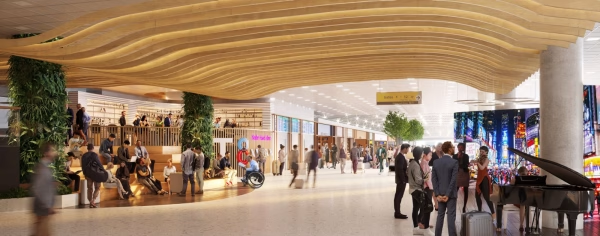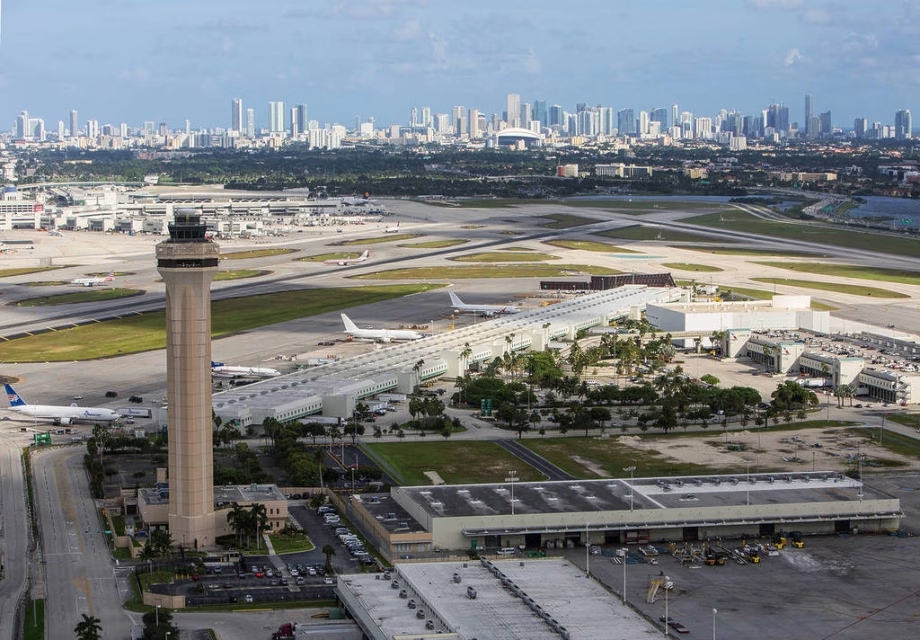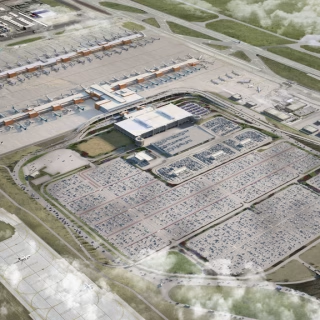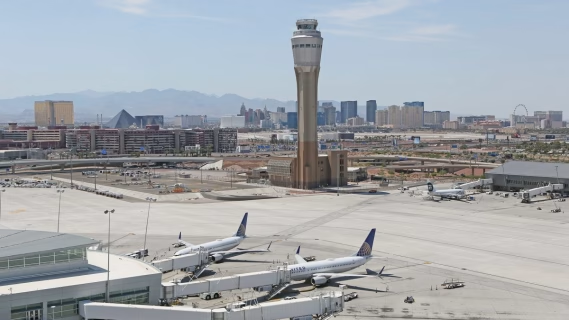When it comes to aviation, runway length is more than just a number — it determines the size of aircraft that can operate, the distances they can fly, and even the safety of landings under challenging conditions. Across the United States, a handful of airports stand out for their extra-long runways that handle massive aircraft, intercontinental flights, and even space missions. Here’s a look at the ten longest airport runways in the country and what makes each one unique.
1. Denver International Airport (DEN) — 16,000 feet
Topping the list is Denver International Airport in Colorado. Its Runway 16R/34L is the longest commercial runway in the United States, stretching 16,000 feet (4,877 meters). Denver’s high altitude and often unpredictable weather mean longer runways are necessary for safe takeoffs and landings, especially for fully loaded long-haul jets heading overseas.
The Great Hall project
Denver International Airport (DIA) has announced the final phase of its ambitious Great Hall renovation, a major overhaul of the Jeppesen Terminal aimed at highlighting “the spirit of Colorado” and improving passenger experience. Originally started in 2018, the multi-phase project has faced budget and timeline adjustments, with total costs now expected to stay below \$1.3 billion and completion targeted for 2027. Despite construction challenges, airport officials promise minimal impact on travelers. DIA CEO Phil Washington emphasized that the Great Hall upgrades will be transformative compared to other planned projects, which include a seventh runway, an 11-gate extension of Concourse C West, and significant improvements to Peña Boulevard — the airport’s main access road, which has seen traffic increase by 80% since DIA opened in 1995. With passenger numbers projected to grow from 78 million in 2023 to 120 million by 2045, the airport also plans a new multi-story rental car facility for 17,500 vehicles, expanded baggage claim areas, and an enlarged international arrivals section. Additionally, 14 new train cars will replace aging units on the airport’s internal transit system. Local funding will largely cover the final phase, with some federal support for modernization projects.
2. John F. Kennedy International Airport (JFK) — 14,572 feet
New York’s JFK Airport is one of America’s busiest international gateways. Runway 13R/31L, nicknamed the “Bay Runway,” measures 14,572 feet (4,439 meters). It handles many of the airport’s largest aircraft, including fully loaded Airbus A380s and Boeing 747s flying long-haul routes to Asia and the Middle East.
JFK terminal redevelopments
John F. Kennedy International Airport’s Terminal 5 is about to undergo a significant transformation designed to elevate the passenger experience and showcase New York’s distinctive cultural energy. Opened in 2008 and serving as JetBlue’s primary hub, Terminal 5 will see its central concourse completely redesigned with a park-inspired look, featuring lush greenery, park benches, chess tables, and warm, inviting lighting that captures the feel of New York’s iconic green spaces. Travelers can expect pop-up experiences, live performances, and interactive events that bring the city’s vibrancy right into the terminal.
A major highlight of this redevelopment is the addition of more than 40 new concessions, including beloved local names like Eataly, Shake Shack, The Halal Guys, Jacob’s Pickles, Serafina, Gotham Burger, and DiFara Pizza — giving passengers an authentic taste of New York. JetBlue also plans to open its first-ever airport lounge at JFK by late 2025, with the entire Terminal 5 upgrade on track for completion by the end of 2026.
Meanwhile, the Port Authority of New York and New Jersey, in partnership with American Airlines and Unibail-Rodamco-Westfield (URW) Airports, is carrying out a \$125 million commercial redevelopment of Terminal 8. This project will add a new great hall and more than 60 new shopping and dining options, highlighting locally owned and diverse businesses to boost community economic opportunities. The lineup will feature world-renowned culinary names like Eataly and Momofuku, along with New York favorites such as Black Tap, Alidoro, and Harlem Chocolate Factory.
These upgrades are part of the Port Authority’s broader \$19 billion plan to transform JFK into a world-class global gateway — driving local business growth, expanding economic impact, and ensuring that Terminals 5 and 8 become memorable and uniquely New York parts of every journey.
3. Southern California Logistics Airport (VCV) — 13,050 feet
Located in Victorville, California, the Southern California Logistics Airport has a massive 13,050-foot (3,978-meter) runway. This former Air Force base is now used for cargo operations, aircraft storage, and heavy maintenance. Its long runway easily accommodates large cargo planes and aircraft under refurbishment.
4. Chicago O’Hare International Airport (ORD) — 13,000 feet
One of the world’s busiest airports, Chicago O’Hare boasts Runway 10L/28R at 13,000 feet (3,962 meters). The length supports heavy intercontinental flights year-round and allows for operations in Chicago’s notoriously harsh winter weather.
Chicago O’Hare International Airport Expansion plans
Chicago O’Hare International Airport’s massive expansion originally unveiled in 2018, the plan aims to transform O’Hare into a modern global hub with increased gate capacity and enhanced passenger facilities. Due to rising costs, the construction sequence was restructured: Satellite Concourse 1 — designed by SOM, Ross Barney Architects, Arup, and JGMA — will be built first, followed by the signature Studio Gang-designed O’Hare Global Terminal that will replace Terminal 2.
Concourse 1 is expected to open by 2028, the Global Terminal by 2032, and the connecting tunnel, people mover, and Satellite Concourse 2 by 2034. Once completed, the expansion will add about 25% more gates and a second customs and immigration checkpoint, creating the nation’s first terminal dedicated to airline alliances, benefiting major hub carriers United and American Airlines.
Site preparation for Satellite Concourse 1 is already underway, supported by a $1 billion bond issuance. In parallel, the city has opened bidding for 21 new concessions contracts covering 75 eateries, 34 stores, and three duty-free shops in Terminals 1 and 3, ensuring that O’Hare’s upgrade will bring more choices for passengers alongside increased capacity.
5. Dallas/Fort Worth International Airport (DFW) — 13,400 feet
Texas’s DFW Airport has Runway 17C/35C measuring 13,400 feet (4,084 meters). It’s one of the longest commercial runways in the country and supports DFW’s status as a major international hub, especially for long-haul cargo and passenger flights.
The $12 Billion DFW Forward Plan
Dallas Fort Worth International Airport (DFW) earlier this year reached a significant milestone in its ambitious $3 billion redevelopment of Terminal C by successfully moving six massive prebuilt megastructure modules into place. This engineering achievement, completed overnight using self-propelled modular transporters across two closed runways, marks a breakthrough in airport construction. The largest of these modules measures 204 feet long, 68 feet wide, and weighs about 1,200 tons.
The Terminal C expansion will add nine new gates by 2026, supporting DFW’s record passenger growth while minimizing airside interruptions. DFW is also applying similar modular methods for expansions at Terminals A and the future Terminal F.
This first phase of Terminal C’s overhaul includes a new 115,000-square-foot pier-style extension and a complete reconstruction of the adjacent parking garage to accommodate increased traffic. The project is being delivered through a design-build collaboration led by HNTB, KAI, ADPI, Austin Commercial, Azteca Enterprises, Alpha & Omega, and design partners HOK and Muller & Muller, Ltd. This milestone demonstrates DFW’s commitment to innovation and efficient large-scale airport construction.
8. Alaska Anchorage Ted Stevens International Airport (ANC) — 12,400 feet
Anchorage’s Runway 7R/25L is 12,400 feet (3,780 meters) long. Anchorage is one of the busiest cargo hubs in the world, and its runway supports massive freighters like the Boeing 747-8 and Antonov An-124, which often stop here to refuel on trans-Pacific routes.
6. Miami International Airport (MIA) — 13,000 feet
Miami International Airport serves as a major gateway for Latin America and long-haul cargo operations. Its longest runway, 8R/26L, is 13,000 feet (3,962 meters) long, supporting large cargo aircraft and long-haul passenger flights.
Concourse K terminal construction
Recenty Miami International Airport (MIA) officially broke ground on Concourse K, its first terminal expansion in nearly two decades, as part of the airport’s ambitious $9 billion “Future-Ready Modernization in Action” program. The $600.6 million Concourse K project will add six new gates, an aircraft apron with a fuel hydrant system, a new ground support equipment maintenance facility, and two more baggage make-up carousels. These upgrades will seamlessly connect MIA’s Central and South Terminals, significantly boosting efficiency.
This expansion comes at a critical time — MIA handled 56 million passengers and over 3 million tons of cargo in 2024, with projections pointing to 77 million passengers and 5 million tons of cargo by 2040. With one of the longest runways in the country at 3,900 meters, MIA is already equipped for the world’s largest aircraft but urgently needs more gate capacity.
Led by Airport Director Ralph Cutie, with Perez & Perez Architects Planners, Inc. and Lemartec-NV2A JV, LLC, the project is targeting LEED Silver certification and aims to redefine MIA as a modern global gateway. Full completion and integration into airport operations are expected by spring 2029.
7. Salt Lake City International Airport (SLC) — 12,003 feet
Salt Lake City International Airport is located in Salt Lake City, Utah. Its 16L/34R runway at 12,003 feet (3,659 meters) makes it one of the longest runways in the USA. The extra length helps aircraft handle high-altitude operations and heavy takeoff weights for transcontinental and international routes.
Salt Lake City International Airport redevelopment program
Currently the airport is in the middle of a 12 year $5.2-billion Salt Lake City International Airport redevelopment program. The four overlapping phases have replaced the original six-decade-old terminal with a modern facility designed for growth. Phase 1, finished in 2020, delivered the central terminal and parts of Concourses A and B. Phase 2 completed more gates, the Central Tunnel, and demolished the old airport, recycling 85% of its materials. Phase 3, wrapping up now, includes the final sections of the tunnel, more gates, and amenities like new Delta and Amex lounges. Phase 4, set to finish in 2026, will add 16 more gates, bringing the total to 94.
8. Harry Reid International Airport (LAS) – 14,515 feet
Formerly known as McCarran International Airport is located in Las Vegas Valley. Its runway 8L/26R is 14,515 feet (4,424 metres) long.
Development plans at the airport
Harry Reid International Airport is planning a major expansion of Terminal 1, adding 26 new gates and replacing the outdated satellite gate layout with a modern pier design, increasing the terminal’s capacity to 65 gates. This modernization aims to address aging infrastructure and improve operational functionality with larger hold rooms, improved technology, and better passenger circulation. The plan will reclaim land once used for the demolished Terminal 2, adding about 46,000 square feet of new space.
Beyond Terminal 1, Terminal 3 will be rebranded as the new Terminal 2, with upgrades to curbside access, ticketing, baggage handling, and security checkpoints, including new express elevators. A terminal-to-terminal flyover roadway will separate airport and commuter traffic, supported by a rehabilitated Reid Airport Connector tunnel. Two multimodal centers are also planned to enhance access to rideshare, public transit, and rental cars.
No timeline or cost estimate has been given yet
Bigger Runways, Bigger Opportunities
From commercial airliners to experimental spacecraft, these massive runways enable some of the world’s most ambitious flights. As aviation technology advances and aircraft grow larger, these long runways ensure that America remains ready for the next era of air travel.
